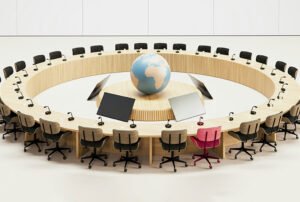
June 14, 2016; New York Times, “Opinion”
The debate over the potential role of for-profit organizations in public education isn’t unique to the United States. Across the developing world, public education systems struggle, depriving millions of children of a basic education and exposing them to a continued life of poverty. Social entrepreneurs have seen this as an opportunity to cure a pressing social ill while turning a profit. With their entries into the educational systems of Asian, African, and South American countries, they have raised questions about their effectiveness and whether, even if they do benefit the children they teach, they will do more harm than good.
Tina Rosenberg took a look at the efforts of one company, Bridge International Academies, as it expands into Liberia as part of a government experiment to test the merits of privatization. The story begins with a failing public school effort where “a girl is more likely to be married by 18 than to know how to read. The last two times the University of Liberia held its entrance exams, 15 students passed—out of some 38,000 who took the test. Only 59 percent of 6-to-11-year-olds are actually in school.” Liberia’s president, Ellen Johnson Sirleaf, facing an election in 18 months, came upon the work of Bridge International Academies’ schools in Kenya and Uganda and decided that radical transformation of public education was worth a try if it would improve outcomes.
Bridge International Academies describes itself as “the world’s largest education innovation company serving the 700 million families who live on less than $2 USD per day. We strive to provide the highest quality education product to the more than 100,000 students who attend Bridge’s more than 400 nursery and primary schools across emerging markets in Africa and (soon to open) in Asia.” What attracted President Sirleaf to their model was their claim of documented success:
Results show that Bridge pupils gain an additional .34 standard deviations on core reading skills and an additional .51 standard deviations on maths compared to their peers in neighboring schools, based on USAID-designed exams administered by an independent monitoring and evaluation company—this translated into over 250 additional days of learning. Thanks to economies of scale, Bridge is able to charge just $6 a month per pupil on average with academies reaching operational sustainability after just one year.
Comparing its current national system against these results makes Liberia’s decision to invite private operators to take over 150 public schools quite understandable and with little downside. The current system is failing, and the government on its own does not seem to have the ability to make it better. If firms like Bridge can bring that improvement, how could anyone say no?
Sign up for our free newsletters
Subscribe to NPQ's newsletters to have our top stories delivered directly to your inbox.
By signing up, you agree to our privacy policy and terms of use, and to receive messages from NPQ and our partners.
Our experience with privatization in the United States has some lessons that Liberia and other developing countries can learn from. Improving education in one school is difficult, but not unusual. The real challenge comes in taking the successful innovations to scale and bringing equal education to all children. The Liberian experiment would do well to be thinking about that issue as it begins.
But establishing parallel systems, one its traditional public model and the other made up of privately run schools, is not without risk. Bridge’s model includes a small monthly fee; it will serve as an obstacle for a large portion of the population who will not be to afford it, creating a further barrier between the poor and the less poor. While the Liberian government seems aware of this pitfall and has taken steps to control the downside as far as possible during the experimental year, there is real concern that should the private school model prove more effective, the cost of expansion is beyond the government’s resources, resulting in an unwanted two-tier system.
Others worry that the sponsors of private schools have the ability to augment funding for their students, resulting in another force pushing the two approaches farther apart. The Liberian government has ensured that public funding for the new private schools will be the same as that given current public schools. But private operators are not barred from using their own funds to augment their schools as they begin, and they plan to do so. Paul Skidmore, the founder and chief executive of Rising Academies, another one of the potential private operators entering Liberia, told the Times, “We operators are asked, as far as possible, to live within that amount. That will be impossible, as there are large upfront costs that operators will have to pay themselves.”
Under these conditions, the new model may not be fiscally viable and scalable. What remains to be seen is whether, as for-profit ventures, they can produce improved results without relying on their owners’ willingness to operate at a loss and see this as part their overall objectives.
In Liberia, private operators have been asked to use state-certified teachers rather than those they have trained in Teach for America–like programs. In return, the private operators have asked for the right to select the teachers they want to implement their program. Will this result in the new schools having the best teachers, leaving the less effective ones to the rest of the nation’s schools? Can they achieve better results if they don’t “skim” their personnel?
A year from now, Liberia will have the results from the first year of the experiment. How they and other nations seeing privatization as the answer to improving their public educational systems will balance improvement for some students with the needs of the whole will test their capabilities. Government effectiveness is not their strong suit, so the real danger is that their private partners will not see the national concern as more important than maintaining their particular share of the market. If that happens, the dangers of two-track education will become a reality, and millions of children will miss the chance for a better life.—Martin Levine












